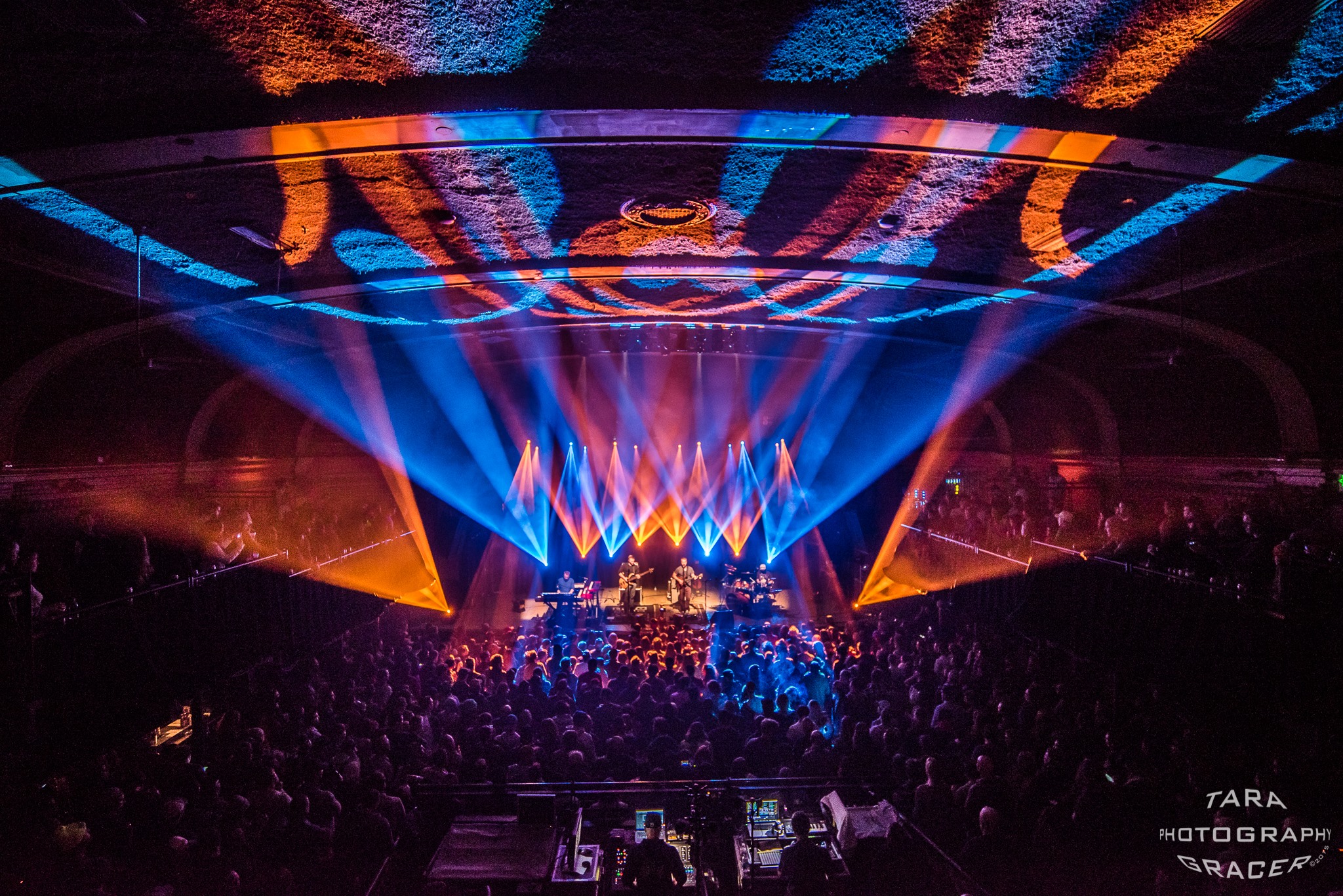
Brian Moss’ commitment to improvisation runs deep – so deep that this past November he and his Spafford band members thought up a little experiment. Instead of taking the stage themselves at Globe Hall in Denver, they asked their crew to hop up there for the first few minutes of the second set. Pretty soon the guitar tech was throwing down bass lines and the lighting director piano melodies, constructing a groove for the band to take over blind. The result? Spafford played for 40 uninterrupted minutes over the original refrain, filled with all of the soaring interplay that’s become familiar territory at Spafford shows.
“These were four dudes that never played music together in their lives,” Moss says. “That’s as true as it can get.”
This, in many ways, represents Spafford’s defining spirit, and why it had a breakout 2017. The Phoenix-based quartet went from playing 100-person rooms in the Southwest to theaters across the country, outdoor festivals, and tours with heavy hitters like Umphrey’s McGee. Its probing, free-form explorations – including the hour-long studio release Abaculus – continue drawing notice on Twitter and elsewhere. “I’m still reveling in what happened in 2017,” Moss says. “I’m still living it.”
Spafford remains on tour from now until late March, with dates booked from DC to Santa Barbara. Though he’s careful not to attribute the success to any one factor, Moss admits he’s seen the appetite growing for the white-canvas way in which they play.
“It indicates that there are people out there who can hear music the same way musicians can,” the guitarist says. “Not everybody can play an instrument, but most people have the ability to really feel it.”
That’s the important part. Because of the relatively unstructured format, performances could very easily turn banal. Some bands use synthesizers and effects to construct lengthy, dissonant soundscapes. Others, notably the Grateful Dead, might play only percussion instruments for a half hour at a time. Not so with Spafford. They’ve hit on a rare blend of instrumentalism, funk, and thematic bliss that’s resonating with more and more live music fans. Crowds now expect them to deliver on the promise that the music will take them to a place they otherwise can’t access.
How long can they keep that up?
“The way that the chemistry works with these four members, it’s not very difficult for us,” Moss says. “We don’t have to think too much to make it work in that way. We’re having a conversation of music and for a musician, that’s the most satisfying thing in the world.”
EK: When did you realize you wanted to make it work in that way? Did it come from hearing other bands?
BM: Any time I went to see other bands play, I never enjoyed being in the crowd. Never in my entire life. I always wanted to be onstage. There’s only a few select bands and that was in my youth. When I listen to the music, I listen really intently. Sometimes I’m not even dancing or enjoying myself. I’d rather just stand there. I’m listening.
EK: Because you always feel like you have something to add?
BM: My mind is always going. It’s very rare that I can let loose and really enjoy myself at a show.
EK: When you’re up onstage now, can you tell that it’s something the audience is connecting right away? Or not?
BM: It goes back and forth. There’s an energy between the band and the fans. It bounces off of each other. Some cities are rowdier than others. Some nights are rowdier than others.
Expectations completely change from venue to venue and night to night.
EK: I find that sometimes I like when things go in a more ambient, quiet direction. Do audiences respond well to that type of jamming, too? Where it’s more thematic and emotional.
BM: Well there’s always a theme we’re working on, and there’s always an ebb and flow to the night. We can’t be going at 120 miles per hour at all times or else we’ll run out of steam. Not only do we need to rest on stage but the audience needs a rest as well so they’re not being smothered. That way you can reassess yourself.
EK: I think of the section starting at around 20 minutes in “Cabin Jam 2” as a perfect example of building a slow, patient theme that culminates very fast, with an almost Latin flavor thrown in. Then it calls back to the earlier theme. Can you talk a little about how you developed that style?
BM: I just played and played and played – as far back as I can remember. In my old high school days, we got out of school at 3:16. We would go run back to my house, into the basement, and jam until like 5:30 when my mom came home. Every single day without question for four years. We didn’t have to try hard to do it. We just loved doing it. For me, I don’t get too afraid of any situations, any chord changes, unless it’s some superior jazz stuff. A lot of it is just ear training: If I hit that button, what does it do when those guys are hitting those buttons? Then after 20-something years of doing it, you start piecing it together. As far as the Latin stuff, I didn’t get into it until I went to school for two years and started learning about big bands and other disciplines. Everything we were learning in school, we were taking and incorporating into the band at some point.
EK: You guys have a little bit of a Latin-funk type of feel at times.
BM: Absolutely. But we like everything. We like reggae, jazz, funk, techno, trance, we like it all.


No Comments comments associated with this post